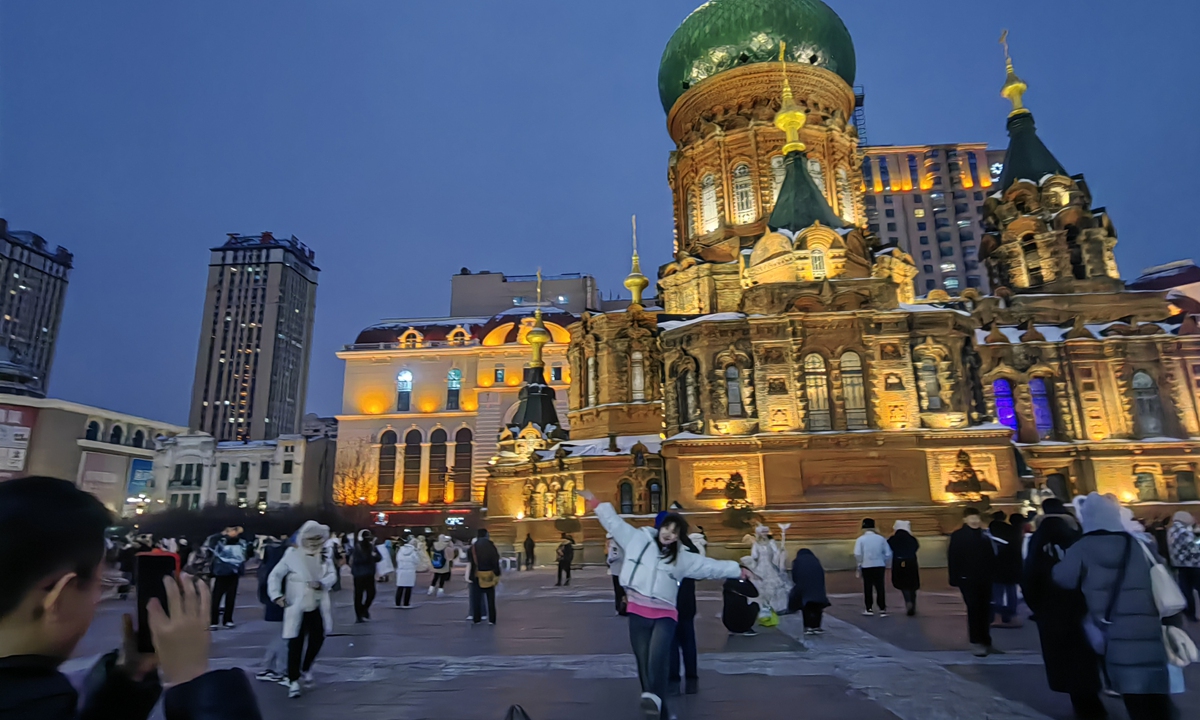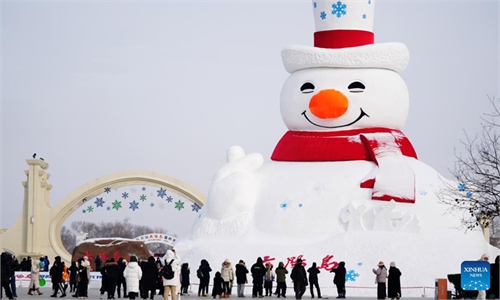
Tourists take photos in front of the Saint Sophia Cathedral in Harbin, Northeast China's Heilongjiang Province, on January 4, 2024. Photo: VCG
Cities in Northeast China see a robust growth in tourism revenue in early 2024, with the industry recovering to the 2019 level, injecting new impetus for the economic development of the region, Chinese experts said.
The flourishing tourism is reflected on the stock market, with many travel companies such as Dalian Sunasia Tourism Co and Changbai Mountain Tourism Co saw their stock prices hit daily rise ceiling on Monday.
Several travel platforms have also showed positive business growth in the region, highlighted by the International Ice and Snow Festival which kicked off on Friday in Harbin, marking the start of the peak season for winter tourism.
Data that travel platform Mafengwo.com sent to the Global Times on Monday shows that the online tourism asset index in the three northeastern provinces - Heilongjiang, Jilin and Liaoning - from January 1 to Sunday increased by 7.2 percent compared to the same period in 2023, reaching 92 percent of 2019 levels.
Specifically, during the same period, the online tourism asset index for Harbin city rose by 15.56 percent compared to the same period in 2023, restoring to 2019 levels before the COVID-19 outbreak.
According to another online travel agency Ctrip's data, Harbin, renowned for its "wintry charm" in ice and snow tourism, continued to deliver significant results from late last year to the beginning this year.
The popular Harbin Ice and Snow World announced a ticket suspension on the second day of the New Year. The report indicates that 75 percent of Harbin's out-of-town visitors during the New Year's Day holidays came from Shanghai, Shenzhen and Beijing, with a remarkable 158 percent year-on-year surge in tourism orders during the 3-day holidays.
Data from the retail platform Meituan shows that, following Harbin, cities like Qiqihar and Daqing in Heilongjiang Province have experienced explosive tourism growth too. In Qiqihar, during the holidays, the city's year-on-year tourism revenue growth, including accommodation and tickets, rose 160.2 percent over last year. Leisure and entertainment-related orders saw a staggering year-on-year growth of 866.5 percent.
The tourism boom not only demonstrates the vitality of China's consumption market, but also points to economic revival in the whole Northeast China region, experts said.
The booming cultural and tourism scene in Harbin is expected to have a positive impact on the overall revitalization of Northeast China, driving growth in modern service industries including tourism, accommodation, catering, transportation, cultural and creative gifts, online booking, and courier delivery, Da Zhigang, director of the Institute of Northeast Asian Studies at Heilongjiang Provincial Academy of Social Sciences, told the Global Times.
The surge in cultural and tourism activities in Harbin also provides valuable insights for the region's future development.
"The bustling cultural and tourism activity in Harbin indicates that the tourism industry, especially winter tourism, can transform into a consumption phenomenon, becoming a genuine economic engine," Da said.
In 2023, there were 2,089 new enterprises involved in ice and snow tourism-related businesses across the country, marking a growth of 23.9 percent year-on-year and hitting the highest growth rate since 2018. The concentrated regions for ice and snow enterprises primarily include Northeast China, said a report by the China Tourism Academy (CTA).
It is anticipated that during the 2023-2024 ice and snow season, the number of leisure tourists engaging in ice and snow activities in China will surpass 400 million for the first time, with the potential business revenue for ice and snow leisure tourism activities could reach 550 billion yuan, the CTA's report said.
Global Times

